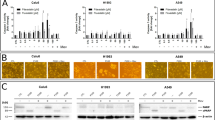Abstract
The impact of the 3-hydroxy-3methylglutaryl CoA reductase inhibitor simvastatin on human small-cell lung cancer (SCLC) cell growth and survival was investigated. Simvastatin profoundly impaired basal and growth factor-stimulated SCLC cell growth in vitro and induced apoptosis. SCLC cells treated with simvastatin were sensitized to the effects of the chemotherapeutic agent etoposide. Moreover, SCLC tumour growth in vivo was inhibited by simvastatin. These responses correlated with the inhibition of stem cell factor (SCF)-stimulated activation of extracellular signal-regulated kinase (Erk), protein kinase B (PKB) and ribosomal S6 kinase by simvastatin. Constitutive activation of the Erk pathway was sufficient to rescue SCLC cell from the effects of simvastatin. The drug did not directly affect activation of c-Kit or its localization to lipid rafts, but in addition to its ability to block Ras membrane localization, it selectively downregulated H-Ras protein levels at the post-translational level. Downregulation of either H- or K-Ras by RNA interference (RNAi) did not impair Erk activation by growth factors, whereas an RNAi specific for N-Ras inhibited activation of Erk, PKB and SCLC cell growth. Together our data demonstrate that inhibiting Ras signalling with simvastatin potently disrupts growth and survival in human SCLC cells.
This is a preview of subscription content, access via your institution
Access options
Subscribe to this journal
Receive 50 print issues and online access
$259.00 per year
only $5.18 per issue
Buy this article
- Purchase on Springer Link
- Instant access to full article PDF
Prices may be subject to local taxes which are calculated during checkout









Similar content being viewed by others
References
Arcaro A, Gregoire C, Boucheron N, Stotz S, Palmer E, Malissen B et al. (2000). J Immunol 165: 2068–2076.
Arcaro A, Khanzada UK, Vanhaesebroeck B, Tetley TD, Waterfield MD, Seckl MJ . (2002). EMBO J 21: 5097–5108.
Arcaro A, Volinia S, Zvelebil MJ, Stein R, Gout I, Layton MJ et al. (1998). J Biol Chem 273: 33082–33090.
Chan KKW, Oza AM, Siu LL . (2003). Clin Cancer Res 9: 10–19.
Chun K-H, Lee H-Y, Hassan K, Khuri F, Hong WK, Lotan R . (2003). Cancer Res 63: 4796–4800.
Furst J, Haller T, Chwatal S, Woll E, Dartsch PC, Gschwentner M et al. (2002). Cell Physiol Biochem 12: 19–30.
Graaf MR, Beiderbeck AB, Egberts ACG, Richel DJ, Guchelaar H-J . (2004a). J Clin Oncol 22: 2388–2394.
Graaf MR, Richel DJ, van Noorden CJF, Guchelaar H-J . (2004b). Cancer Treat Rev 30: 609–641.
Heasley LE . (2001). Oncogene 20: 1563–1569.
Hirai A, Nakamura S, Noguchi Y, Yasuda T, Kitagawa M, Tatsuno I et al. (1997). J Biol Chem 272: 13–16.
Hiwasa T, Nakagawara A . (1998). Biochem Biophys Res Commun 250: 741–746.
Jiang K, Coppola D, Crespo NC, Nicosia SV, Hamilton AD, Sebti SM et al. (2000). Mol Cell Biol 20: 139–148.
Johnson BE, Heymach JV . (2004). Clin Cancer Res 10: 4254s–4257s.
Krystal GW, Sulanke G, Litz J . (2002). Mol Cancer Ther 1: 913–922.
Kusama T, Mukai M, Iwasaki T, Tatsuta M, Matsumoto Y, Akedo H et al. (2001). Cancer Res 61: 4885–4891.
Lee SJ, Ha MJ, Lee J, Nguyen P, Choi YH, Pirnia F et al. (1998). J Biol Chem 273: 10618–10623.
Mitsudomi T, Viallet J, Mulshine JL, Linnoila RI, Minna JD, Gazdar AF . (1991). Oncogene 6: 1353–1362.
Moore SM, Rintoul RC, Walker TR, Chilvers ER, Haslett C, Sethi T . (1998). Cancer Res 58: 5239–5247.
Pardo OE, Arcaro A, Salerno G, Raguz S, Downward J, Seckl MJ . (2002). J Biol Chem 277: 12040–12046.
Pardo OE, Arcaro A, Salerno G, Tetley TD, Valovka T, Gout I et al. (2001). Oncogene 20: 7658–7667.
Salgia R, Skarin AT . (1998). J Clin Oncol 16: 1207–1217.
Tsao H, Zhang X, Fowlkes K, Haluska FG . (2000). Cancer Res 60: 1800–1804.
Wistuba II, Gazdar AF, Minna JD . (2001). Semin Oncol 28: 3–13.
Wolfman JC, Wolfman A . (2000). J Biol Chem 275: 19315–19323.
Acknowledgements
We thank Dr R Marais and Dr U Zangemeister-Wittke for reagents. This work was supported by a grant from the Association for International Cancer Research to AA and a Program Grant from Cancer Research UK to MJS.
Author information
Authors and Affiliations
Corresponding author
Additional information
Supplementary Information accompanies the paper on Oncogene website (http://www.nature.com/onc)
Supplementary information
Rights and permissions
About this article
Cite this article
Khanzada, U., Pardo, O., Meier, C. et al. Potent inhibition of small-cell lung cancer cell growth by simvastatin reveals selective functions of Ras isoforms in growth factor signalling. Oncogene 25, 877–887 (2006). https://doi.org/10.1038/sj.onc.1209117
Received:
Revised:
Accepted:
Published:
Issue Date:
DOI: https://doi.org/10.1038/sj.onc.1209117
Keywords
This article is cited by
-
Therapeutic targeting of the mevalonate–geranylgeranyl diphosphate pathway with statins overcomes chemotherapy resistance in small cell lung cancer
Nature Cancer (2022)
-
Statins: a repurposed drug to fight cancer
Journal of Experimental & Clinical Cancer Research (2021)
-
Statins decrease the expression of c-Myc protein in cancer cell lines
Molecular and Cellular Biochemistry (2021)
-
Progression and metastasis of small cell lung carcinoma: the role of the PI3K/Akt/mTOR pathway and metabolic alterations
Cancer and Metastasis Reviews (2021)
-
Membrane Dynamics in Health and Disease: Impact on Cellular Signalling
The Journal of Membrane Biology (2019)



